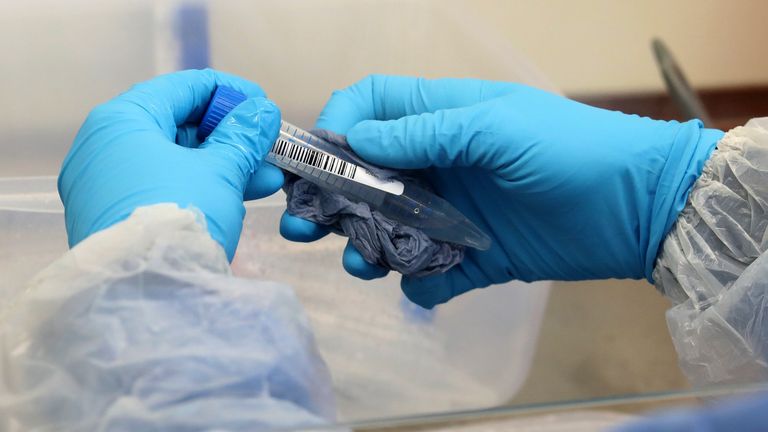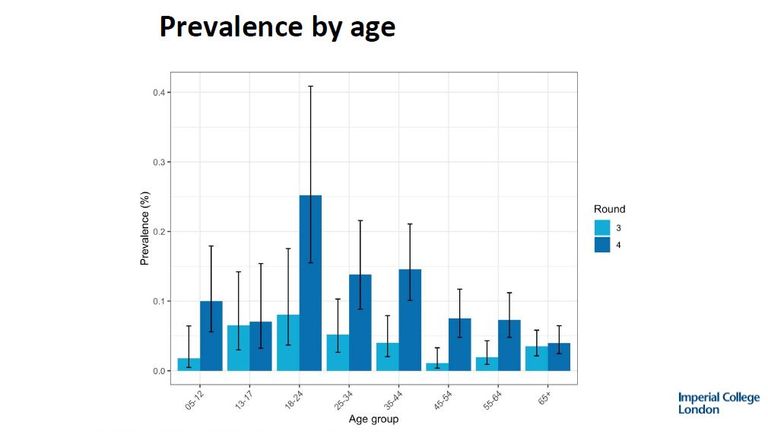The rate of COVID-19 transmission has risen above a critical level that means the infection is growing exponentially, official figures show.
According to the Scientific Advisory Group for Emergencies (SAGE), the latest estimate for R across the UK is between 1.0 and 1.2.
The number represents the average number of people each person with coronavirus goes on to infect.
At the same time, the number of newly diagnosed cases continues to rise, with higher incidence seen in young people aged 18 to 24 years.
The last time the reproduction rate was above one was in early March.
It is understood that schools and universities are expected to cause a further increase in the spread of COVID-19.
The updated R figure comes as a ban on gatherings of more than six people is due to come into force in a bid to curb the spread of the coronavirus, while households will be barred from meeting each other in Birmingham, Sandwell and Solihull after a spike in cases.
Meanwhile, separate data, which fed into the SAGE number, indicates that coronavirus cases are doubling every week in England and the R number could reach as high as 1.7.
Scientists leading the research reinforced the need for the “rule of six” for social gatherings following the findings.
Levels of infection were examined in the general population in England after more than 150,000 volunteers were tested for the Real-Time Assessment of Community Transmission (REACT-1) study.
Out of 152,909 swab results, 136 were positive, and prevalence doubled every 7.7 days, the figures suggest.
It is estimated that 13 people per 10,000 were infected with COVID-19 in England between 22 August and 7 September, compared to four people per 10,000 between 24 July and 11 August 2020.
The prevalence is much lower than mid-March, when the speed of increase was three to four days (with a higher number of infections), but it is higher than experts would like.
Based on the results, scientists estimated the R number to be 1.7.
Health Secretary Matt Hancock said: “We’ve seen all across the world how a rise in cases, initially among younger people, leads to hospitalisations and fatalities. The pandemic is not over, and everyone has a role to play to keep the virus at bay and avoid further restrictions.
He added that it is “so important” that everyone abides by the law and socialises in groups up to six.
The research found that the virus is no longer clustering in healthcare or care home settings, as seen in May and June, suggesting it is now spreading widely in the community.
Infections are increasing across all adult age groups below the age of 65 and across all parts of the country.
Higher rates of coronavirus has been see in young people aged 18 to 24, with the infection highest in Yorkshire and the Humber, the North East and the North West.
Black, Asian, mixed and other ethnicity groups (BAME) were associated with higher prevalence of infection at 0.20%, 0.20%, 0.16% and 0.23% respectively compared with white ethnicity at 0.08%.
The study is one of several that feed into government decision-making and policies on tackling the spread of COVID-19 in England.
Professor Paul Elliott, director of the programme at Imperial from the School of Public Health, said: “Our large and robust dataset clearly shows a concerning trend in coronavirus infections, where cases are growing quickly across England and are no longer concentrated in key workers.
“What we are seeing is evidence of an epidemic in the community and not a result of increased testing capacity. This is a critical time and it’s vital that the public, our health system and policy-makers are aware of the situation as we cannot afford complacency.”
Prof Elliot said the findings act as an “early warning” sign for the government to take into account.
He added: “This study was designed as an early warning system and that is what it has given – an early warning.
“We gave our data and findings to the government and it is one of a number of studies they will have considered before making the recent changes.”



